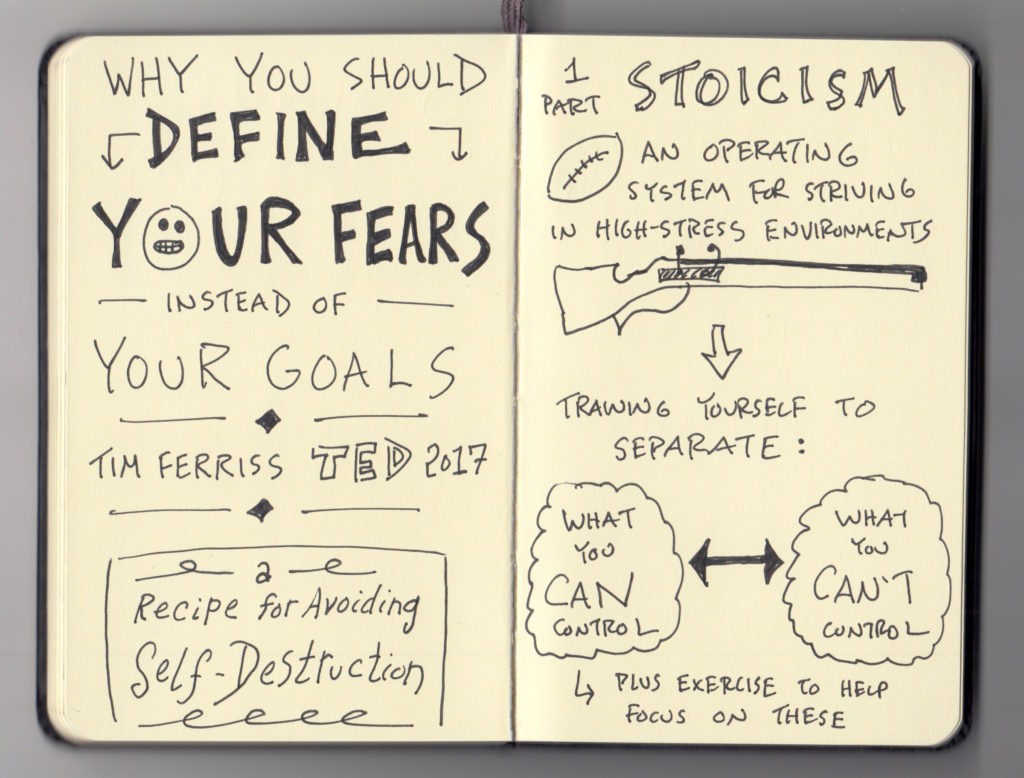I was reading the 4-Hour Workweek by Tim Ferris last week. In one of his chapters, he talks about taking control of your life and controlling your fears. He gives an excellent exercise in his book’s chapter 24 (“Face Your Fears”).
Fear-Setting is a helpful exercise that will give new insight and understanding about your fears.
The exercise is simple: list all of your fears from the most to the least important…
For example, my list would look something like this:
1) Dying Prematurely
2) Becoming Homeless
3) Losing My Job
4) Rejection
5) Fear of Public Speaking
6) Failure
After you have your list, you need to score each fear on a scale from 1-10, with ten being the most severe.
For me, my fears would score something like this:
1) Dying Prematurely – 9
2) Becoming Homeless – 7
3) Losing My Job – 5
4) Rejection – 4
5) Fear of Public Speaking – 2
6) Failure – 1
The next step is to identify the top 3 fears on your list and focus on them. These are some of the fears that are holding you back from living a great life.
RELATED READING: Tim Ferriss’ Complete Supplement Stack
How to do Tim Ferriss’ Fear-Setting Exercise
To get started with the fear-setting, grab yourself a notebook and allow yourself 30 minutes of uninterrupted time. Fear-Setting takes three pages. This section will explain the exercise in detail. We will outline how to handle the three pages of the fear setting worksheet.
Page 1: Fears and doubts
Start by writing down all your fears for the situation at hand. It can be anything from “I’m afraid I’ll make a fool of myself” to “What if I can’t do it?” Next, write down all your doubts. It is where you list all the reasons why you think your fears are justified. For example, you might write “I’m not smart enough” or “I don’t have enough experience.”
Page 2: Risks and rewards
Now it’s time to list out the risks and rewards. It will help you to clarify the pros and cons of taking action. For example, if you’re afraid of public speaking, the risk might be that you’ll make a fool of yourself, and the reward might be that you’ll have the opportunity to share your ideas with a large audience.
Page 3: A plan of action
The final step is to develop a plan of action to help you overcome your fear. For example, if you’re afraid of public speaking, then you might want to start by practicing in front of a small group of people. By doing this exercise, you can start to take action in the face of fear and make better decisions.
RELATED READING: Dr. Andrew Huberman’s Sleep Cocktail
Find clarity, conquer fear and take action
Once done with the exercise, there is newfound clarity. The fear-setting worksheet brings not just a list of risks and rewards but a plan of action to address the fears head-on. That’s not all; conquering said fears could also lead to remarkable personal growth. It becomes easier to take on new challenges when success in one area has already been tasted.
Uncovering fear disguised as optimism
There is a certain kind of optimism that masquerades as fear. Fear setting shines a light on this false sense of security by uncovering the root of the worry. It could be something like “I don’t want to try because I’m afraid I’ll fail” or “I’m not sure if I can do it, so I shouldn’t bother.”
A useful technique
The fear-setting technique might seem counterintuitive, but it works. We often want to ignore our fears because they are unpleasant to contemplate. But if left unchecked, they can curdle into anxiety and stop us from taking action. The fear setting gives you the clarity to take on life with gusto.
By doing this exercise, you can start to take action in the face of fear and make better decisions.
RELATED READING: Tim Ferriss’ Slow Carb Diet: The Complete Guide
Understanding Stoicism
Ahhhh, the stoics. This exercise really made me this of Stoicism, a philosophy I’ve been interested in for a while.
Stoicism teaches that you should be indifferent to the things you can’t control and instead focus on the things you can handle. It is a great way to deal with fear.
If you focus on the things you can control, such as your thoughts and actions, you will be less afraid of the things you can’t control, such as the future.
RELATED READING: The Pomodoro Technique Explained: Hack Your Productivity
Fear Warps Up Your Thinking and Inhibits Action
Tim Ferris points out that our fears are usually irrational. We fear things that are extremely unlikely to happen, or if they do occur, the consequences won’t be as dire as we expected. We can’t live life avoiding everything which might have a negative outcome. Our lives are not determined by the specific events that happen but rather by how we react to them.
Tim Ferris talks about the “fear bias in a fear setting.” The fear bias is our natural tendency to overestimate the risk of adverse events and underestimate the probability of positive ones. When we are faced with a choice, our fear often causes us to make the wrong decision. For example, let’s say you are offered a new job. Your fear might cause you to turn down the job offer, even if it is a great opportunity because you are afraid of the unknown.
RELATED READING: Dr. Andrew Huberman’s Diet
Or, you might be scared to start your own business, even though the chances of success are higher than failure because you are afraid of losing your job. Tim Ferris gives an excellent example of how our fear has the power to warp our thinking and inhibit action. He talks about his experience with taking cold showers. He had read somewhere that cold showers were good for you, so he decided to take them to get in shape.
The initial resistance was extremely high the first few times he turned on the shower. He couldn’t bring himself to step into the cold water. He failed several times before finally succeeding. After taking his first few cold showers, his hair became thicker, and he had more energy throughout the day. However, the most critical benefit of taking cold showers was that it helped him overcome the fear.
RELATED READING: Dr. David Sinclair’s Anti-Aging Supplement List
Use fear setting to clarify your thinking and take action in the face of fear
The fear-setting exercise is very effective at helping you clarify your thinking and take action in the face of fear. Fear setting is a way to force yourself to face your fears and assess the risks and rewards of taking action. When you are afraid, it is tough to think straight. The fear bias causes us to make the wrong decisions. Fear setting aims to help you overcome your fear and make better decisions.
RELATED READING: Dr. Andrew Huberman’s Complete Biohacking Supplement List
When to Use Fear Setting
Tim Ferris recommends using fear setting when you have a big decision to make. The best time to use fear setting is when you are afraid of taking action or procrastinating. For example, if you want to quit your job and start a business but are too afraid, it might be good to do some fear setting.
The best way to use fear setting is to sit down and write out a list of pros and cons.
For example, if you are afraid of public speaking, you might want to list the pros and cons of giving a speech. The pros might be that you will have the opportunity to share your ideas with a large audience. The cons might be that you will have to speak in front of many people.
Next, write out all the possible outcomes resulting from your decision. In this case, if you give a speech and it goes poorly, then the outcome would be an embarrassment. If it goes well, the result would be respect from your peers and a sense of accomplishment.
Finally, rank each outcome from one to ten based on how bad it would be if it occurred.
In this case, embarrassment might be ranked at a five. And respect from your peers and a sense of accomplishment might both be ranked at an eight. By doing this exercise, you can understand the risks and rewards of taking action. You can also develop a plan of action to help you overcome your fear.
RELATED READING: Dr. Peter Attia’s Biohacking Toolkit
FAQ
Can I share my fears and doubts with someone else?
It can be helpful to talk about your fears and doubts with someone else. It will help you to get a different perspective on the situation. However, it is essential to make sure the person you are sharing your fears with understands that this is a confidential exercise. It can be helpful to seek professional help if you are struggling to implement this exercise.
Can I use the fear setting for personal growth?
Yes. You can use the fear setting for personal growth in several ways:
1. It can help you to identify your fears and doubts.
2. It can help you understand the risks and rewards of taking action.
3. It can help you develop a plan of action to address your fears.
What if I’m not sure what my fears are?
If you’re not sure what your fears are, you can start by thinking about the situation at hand. What is getting in your way? What is holding you back from doing whatever it is you want to do?
Can I use the fear setting for a specific area of my life, or does it have to be for a particular goal?
Fear settings can be used in any area of your life, although the exercise works best when trying to achieve a specific goal.
Can I use fear setting more than once?
Yes, you can use fear setting more than once. It is recommended that you exercise regularly to keep track of your worries and doubts. It will help you stay on track and take action in the face of fear.
RELATED READING: Dr. David Sinclair’s Longevity Diet & Exercise Protocol
Conclusion
Tim Ferriss, the author of The 4-Hour Workweek, is notorious for his use of fear setting as a tool to keep track of his fears and doubts. The fear setting has helped him clarify his thinking and overcome the hurdles put in front of him.
With this information, you can use fear setting to conquer your fears and take action in the face of fear.



